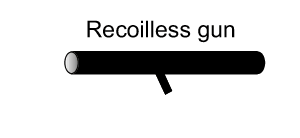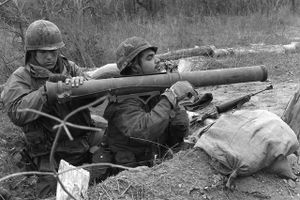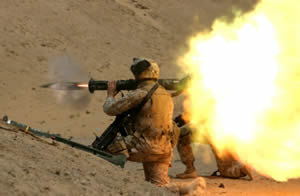Newton's Third Law of Motion
Momentum and Recoil
|
| We are all familiar
with guns recoiling when fired. We may not have fired a gun ourselves but
we have watched enough movies to see this phenomenon in action. Newton's
Third Law of Motion states that "Every action has an equal and opposite
reaction". What Newton was talking about is conserving momentum. We
can also state the Law of Conservation of Momentum. This law states that,
"In the absence of an external force, the momentum of a system remains
unchanged". Now we have introduced to new words, system
and momentum. Let's clarify these two terms. |
|
| What is momentum?
It is a quantity much like force and velocity which have magnitude and
a direction.
We express the momentum of an object by the formula below
Momentum = velocity
X mass of the object
We can see from
the formula that an elephant travelling at 3 m/s has a greater momentum
than a mouse travelling at 3 m/s. A truck travelling at 100 km/hr has
more momentum than when it travels at 30 km/hr. A stationary object has
no momentum. |
| What is a system?
A system is a collection of two or more objects that interact with each
other. For example, a cannon and a cannon ball form a system, as does a
rocket in the barrel of a rocket launcher. Two colliding billiard balls
also form a system. |
| Now, the Law of
Conservation of Momentum states that the momentum of a system must be conserved.
OK! so when I fire a bullet from a gun the total momentum of the gun and
the bullet, known as the system, should be equal to the momentum of the
gun and bullet before firing. As the bullet leaves the gun barrel it has
a momentum equal to its velocity multiplied by its mass (momentum=velocity
X mass). The gun must now move in the opposite direction with a certain
velocity so that its momentum is exactly equal in magnitude and opposite
in direction to the bullet's momentum. This is why the gun recoils. The
bullet is not as heavy as the gun but escapes from the barrel at speeds
around 860 m/s. The gun is much heavier than the bullet so it recoils at
speeds significantly less than that of the bullet but enough to give a serious
jolt. |
| A recoilless gun also obeys
the Law of Conservation of Momentum. The gun does not recoil because it
vents gas out the back. The momentum of the gas escaping out the rear of
the gun is equal to the momentum of the shell. The gun therefore does not
have to move backwards so that momentum is conserved. |
|
| As seen on the right, the mass
and velocity of the gas escaping from the rear of the gun is equal to the
velocity and mass of the shell escaping in the forward direction. Otherwise
the gun would recoil violently |
|
| Recoilless weapons
have been used successfully since WW2. They are generally used to fire
heavier, self-propelled shells that can engage tanks and heavy armour.
|
|
|
|



